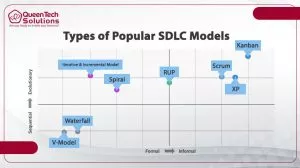- July 20, 2023
- Posted by: Jacky Melek
- Categories: Software Development, Website Development

Software Engineering VS Machine Learning
Machine learning vs software engineering are two distinct disciplines, although they are often interrelated in practice. Here are the key differences between machine learning and software engineering:
- Objective:
– The primary objective of software engineering is to design, develop, and maintain reliable and efficient software systems. Software engineers focus on creating applications that meet specific functional requirements, are scalable, maintainable, and robust.- In contrast, machine learning aims to develop algorithms and models that can automatically learn from data and make predictions or decisions without being explicitly programmed. - Approach:
– Software engineering follows a structured and systematic approach to software development. It involves requirements analysis, system design, implementation, testing, and maintenance. Software engineers write code and design software architectures based on predefined specifications.- Machine learning, on the other hand, relies on data-driven approaches. It involves training machine learning models on labeled or unlabeled data to infer patterns and make predictions. The focus is on building models that can learn and improve over time.
- Data Dependency:
– Software engineering typically does not rely on large amounts of data for development. The emphasis is on designing algorithms and systems based on logic and predefined rules.- In contrast, machine learning heavily relies on data. Training machine learning models requires substantial amounts of labeled or unlabeled data to enable learning and generalization.
- Flexibility and Adaptability:
– Software engineering focuses on building software systems that are adaptable to different scenarios and can handle various inputs and conditions. However, the behavior of the software is determined by the explicit rules and logic programmed by the software engineer.- Machine learning models, on the other hand, can adapt and improve based on new data and experiences. They have the ability to automatically adjust their behavior and make predictions in novel situations. - Skillset:
– Software engineering requires proficiency in programming languages, software architecture design, algorithms, and software development practices. Software engineers need to have a deep understanding of programming concepts and software engineering principles.- Machine learning, while also requiring programming skills, demands knowledge in statistics, data preprocessing, feature engineering, and machine learning algorithms. It involves understanding concepts like overfitting, bias-variance tradeoff, and model evaluation. - Lifecycle:
– The lifecycle of a software engineering project typically involves several stages, such as requirements gathering, design, implementation, testing, and maintenance.- Machine learning projects often involve additional steps, including data collection, data preprocessing, feature selection or extraction, model training, evaluation, and deployment. The iterative nature of machine learning requires continuous monitoring, model updating, and retraining as new data becomes available.
The Impact of Machine Learning On Software Development
Machine learning has had a significant impact on web development, revolutionizing the way websites and web applications are built and enhancing their functionality. Here are some key ways in which machine learning has influenced web development:
Personalized User Experience: Machine learning algorithms enable websites to provide personalized user experiences by analyzing user data, preferences, and behavior.
Intelligent Search and Recommendations: Machine learning algorithms can improve search functionalities on websites by understanding user queries, analyzing patterns, and providing more accurate search results.
Fraud Detection and Security: Machine learning engineering can analyze large volumes of data to detect patterns indicative of fraudulent activities, such as credit card fraud, account hacking, or spam. Web applications can use machine learning-based fraud detection models to identify and prevent such security threats, protecting user data and maintaining a secure environment.
Automated Testing and Bug Detection: can automate the process of testing web applications by analyzing code, detecting bugs, and identifying potential vulnerabilities. This helps in improving the quality and reliability of web applications while reducing the time and effort required for manual testing.
Predictive Analytics: Machine learning can be used to analyze historical data set and make predictions or forecasts. Web developers can leverage this capability to predict user behavior, website traffic patterns, or customer preferences.
Automated Content Generation: Machine learning models can be trained to generate content automatically, such as product descriptions, news articles, or social media posts. This can save time and open sources for web developers and content creators, especially in scenarios where large volumes of content need to be generated.
How to Use Machine Learning In Web Development?
- Define the Problem: Identify the specific problem or use case where data scientists can add value to your web application. For example, it could be personalized recommendations, user sentiment analysis, image recognition, or natural language processing.
- Gather and Prepare Data: Collect or obtain relevant data that will be used to train and evaluate the machine learning model. Clean and preprocess the data by handling missing values, removing outliers, and normalizing or scaling features. Ensure the data is in a format suitable for machine learning algorithms.
- Choose the Right Algorithm: Select the appropriate machine learning algorithm(s) based on the problem you are trying to solve and the characteristics of your data. There are various algorithms available, including decision trees, support vector machines, neural networks, and ensemble methods. Consider factors such as accuracy, interpretability, scalability, and computational requirements.
- Train the Model: Split your data into training and testing sets. Use the training data to train the machine learning model by fitting the algorithm to the data. This involves finding the optimal values for the model’s parameters to minimize the error or maximize the performance metric. Iterate and experiment with different approaches to improve the model’s performance.
- Evaluate and Validate: Assess the performance of your machine learning model using the testing dataset. Evaluate metrics such as accuracy, precision, recall, F1 score, or area under the ROC curve, depending on the problem type (classification, regression, etc.). Validate the model’s performance on new, unseen data to ensure it generalizes well.
- Integrate with Web Application: Once you have a trained and validated machine learning model, integrate it into your web application. Depending on the programming language and framework you are using, you may need to import relevant machine learning libraries or frameworks. Set up the necessary infrastructure to serve predictions or process user inputs in real-time.
- Deploy and Monitor: Deploy your web application with the integrated machine learning functionality to a production environment. Monitor the performance of the machine learning model in real-world scenarios, gather feedback, and continuously improve the model over time. Update the model periodically as new data becomes available or as the web application evolves.
- Maintain Data Privacy and Security: Ensure that appropriate measures are in place to handle sensitive user data and comply with data protection regulations. Implement secure data storage, encryption, and access controls to protect user privacy.
Will machine learning replace software engineering?
In summary, machine learning or any types of AI platform is a powerful tool that enhances certain aspects of software engineering (human brain), but it is not expected to replace software engineering entirely. The two fields software engineering vs machine learning will likely continue to coexist and complement each other as technology progresses.
Machine learning vs. Artificial Intelligence in software
Artificial intelligence (AI) is a broad field of computer science that aims to create intelligent machines capable of performing tasks that typically require human intelligence.
Machine learning and deep learning is a subset of AI that focuses on enabling machines to learn from data and improve their performance without being explicitly programmed.
ML algorithms allow systems to analyze data, extract patterns, make predictions, and take actions based on acquired knowledge. While AI is a broader concept, ML is a specific approach within AI that emphasizes learning from data.
In brief, software engineering focuses on the development and maintenance of software systems, while machine learning and artificial intelligence are subsets of computer science that enable machines to learn, reason, and perform intelligent tasks.
Software engineering provides the foundation for building reliable software, while AI and machine learning enhance software systems with learning and intelligent capabilities. The integration of these fields leads to the development of advanced and innovative technologies with broad applications in various industries.
If you still have doubts or questions, Contact Us, and our managers will be happy to provide more information.




